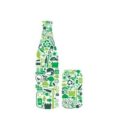Ball Corporation announced its new Climate Transition Plan that will help the company become a fully circular and decarbonized business. This will help them to better satisfy their stakeholders and, at the same time, offer solutions that benefit the planet. In addition, the combined 2022 Report details the company’s commitment to environmental, social and economic sustainability along with product stewardship and social impact targets for 2030.
Ball Corporation, with a long history of 143 years, believes it has sufficient resources to remain in the market and provide adequate services for all its employees, customers, shareholders and communities. This was Dan Fisher’s assurance when presenting the company’s 2022 report and Climate Transition Plan.
“The details shared in our combined 2022 report and Climate Transition Plan demonstrate our commitment to driving innovation and operational excellence in our global aluminum packaging and aerospace businesses. With sustainability as our continued focus, we have a bright future ahead of us.”
he added.
In addition, the Climate Transition project presented by Ball contains a rigorous and transparent scheme based on the recommendations given by the UN that invites companies to reduce net carbon footprint commitments to reduce actual emissions. This proposal explains practical and economically feasible scenarios with consideration of some uncertainty and the possibility of changes during this process, with objective targets set for 2030 and some for before 2050. It also demonstrates Ball’s behavior towards these goals as its participation as a founding member in the World Economic Forum’s Prime Movers Coalition, aiming to digitize the industry.
Ramon Arratia, Director of Sustainability at Ball Corporation, also explained that the fight to preserve the 1.5 degree limit will be defined during this decade and added that Ball’s climate transition plan will enable its customers to achieve Scope 3 emissions targets.
“It will require strong collaboration with customers and suppliers across the value chain, as well as joint policy advocacy for high circularity,”
, he added.
In addition, Ball Corporation is working hard with its suppliers to increase the amount of recycled material used in beverage products. Due to the efforts made, it achieved an overall average of 66%, an increase of only 3% with respect to the immediately preceding period.
In 2022, Ball generated 87% of its revenue from the sale of products that are made from recycled materials, are recyclable and, to a small but growing degree, are rechargeable or reusable. These products include alunium beverage cans, bottles, cups and aerosol cans.











